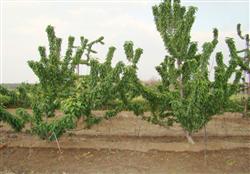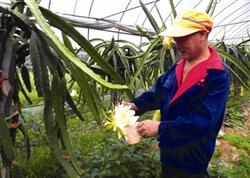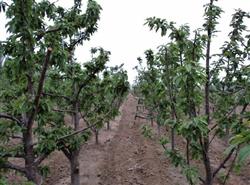How to manage big cherries after picking in summer?

How to manage big cherries after picking in summer? Please give detailed guidance on management methods. Most big cherries are picked from late May to late June, when it is an important period for cherry flower bud differentiation and pest control. How to quickly restore tree potential, promote flower bud differentiation, increase tree storage nutrients, and effectively control diseases and insect pests is a problem that must be solved to achieve continuous high and stable yield of cherries. First, topdressing in time after harvest: cherries should be fertilized immediately after picking, which can timely supplement a large amount of nutrients consumed by tree growth and meet the nutrient needs of flower bud formation and later growth stages. the common method is ditch application of human feces and urine. the combination of compound fertilizer and foliar fertilizer spraying. For the big trees in the full fruit stage, about 30-50 kg of human feces and urine were applied to the trees in the open trench, covered with soil, and then evenly sprinkled 0.5-1 kg of urea and calcium superphosphate in the tree plate, and watered immediately after shallow hoeing. Foliar fertilizer spraying can make nutrients reach the required parts more quickly. Fertilizer should be sprayed many times throughout the growing season to meet the growth needs of the tree. After cherry harvest, combined with pest control, 0.3% urea should be sprayed once, and the tree potential should be sprayed again in about 20 days. Foliar fertilizer should be mainly P and K fertilizer in the later stage. 0.3% potassium dihydrogen phosphate can be sprayed once in July, August and September to prolong leaf life and increase tree nutrients. One of the problems that should be paid attention to in the process of fertilization is that there can be no unlimited fertilization, especially a large amount of N fertilizer and a large amount of watering, which is easy to cause the vigorous growth of cherry trees, spring shoots can not stop growing in time, which is not conducive to flower bud differentiation, and autumn shoots can not be capped in time. It's not safe to survive the winter. Therefore, attention should be paid to scientific fertilization and watering. 2. Reasonable summer pruning: according to the study, the physiological differentiation period of cherry flower buds is mainly concentrated in the spring shoot, which is carried out within about 10 days after fruit harvest, and the morphological differentiation period is completed within 1-2 months, so a variety of summer pruning techniques are used to balance the tree potential. promoting the transformation from vegetative growth to reproductive growth is an important measure to promote flower bud differentiation. In addition, reasonable summer shearing can greatly reduce the amount of winter shearing and save a lot of manpower. 1. Branch thinning: after fruit picking, the upper dorsal branches that are too high and too dense and some of the fruit branches that are too dense are removed in time, and the inner chamber is opened (pay attention to the cultivation of inner chamber branchlets to prevent inner chamber baldness). The temporary fruiting branches, drooping branches, thin and weak branches and peripheral over-dense branches were removed, and 2-3 branches were left on the whorl branches to open the periphery, so that the branches were sparse and dense inside, evenly distributed, and well ventilated and transparent. 2. Retraction: all the fruiting branches that form bare legs should be retracted to the leaf buds to control the outward movement of the fruiting parts. 3. Coring: the inner bore branches retained in the early stage continue to be coring, and if there is room for the new shoots that germinate after retraction, 5-15cm can be left for repeated coring, and the small fruiting branches are cultivated, and the outer new shoots are cut short when they grow to about 40cm. 4. Erase buds: there is no space to erase the new buds that germinate after thinning, retraction and picking the heart. Click to get more cherry tree planting techniques click to get more fruit planting techniques
- Prev

How to prune and pollinate red meat dragon fruit?
How to prune and pollinate red meat dragon fruit? Please introduce the red meat dragon fruit pruning is to achieve the balance between stem and side vines, so that the dragon fruit has reasonable light in a reasonable space, the pruning operation is mainly to pick the heart and cut the new buds which are unreasonable and too dense, through the top to pick the heart, restrain.
- Next

How to manage cherries after harvest?
How to manage cherries after harvest? Please introduce methods of management cherry harvest after the main management methods are: young shoots to promote flower bud differentiation, to prevent excessive vegetative growth, should take the method of young shoots to control. That is to say, the new shoots that have not stopped growing are picked, and the position of picking is generally divided into half leaves; picking...
Related
- Moge, come on! The staff of the peasant association in the producing area of cantaloupe were frightened when the crowd gathered.
- Causes and Solutions of low Fruit setting rate of Apple
- Symptoms and control measures of passion fruit virus disease
- Fruit growing lesson: how do apple orchards keep high yields?
- Can you build orchards in the mountains? What are the pros and cons?
- How to manage the coloring period of Crisson grape?
- This paper introduces the processing technology of two kinds of fig products.
- How much is a month for retired teachers in rural areas by 2020?
- How can strawberry planting increase sugar content? We should pay attention to management in many aspects.
- What are the cultivation techniques on how to improve the yield of golden fruit?

